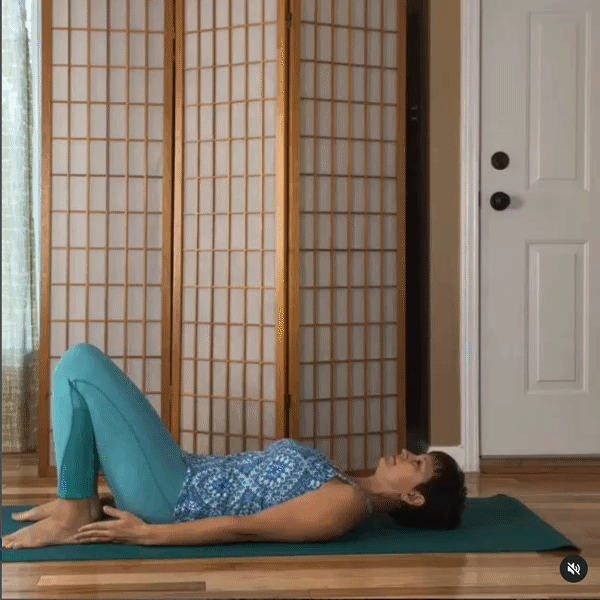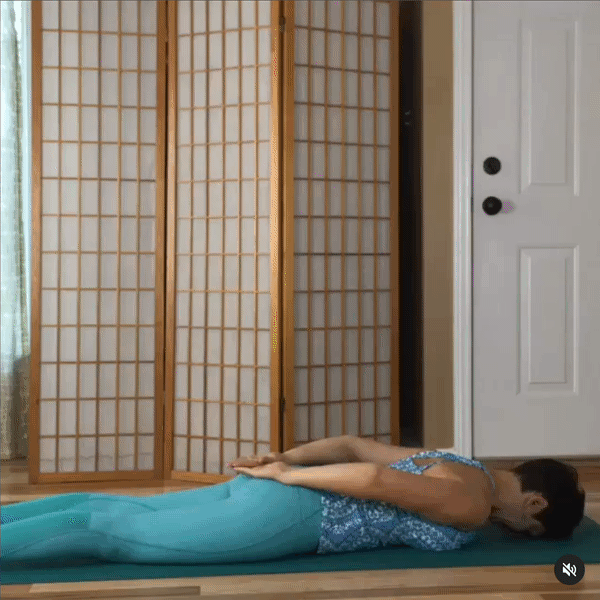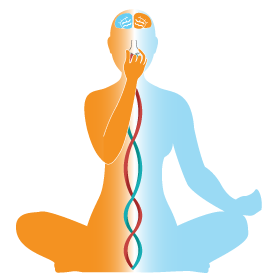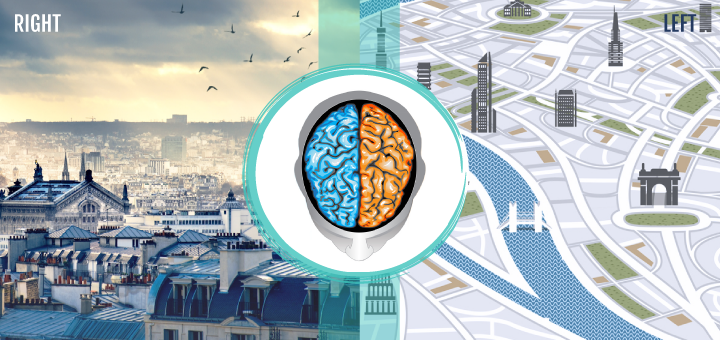How to integrate your right and left brain through movement

The cooperation between our two brain hemispheres is essential for us to learn better, function more intelligently, and become proficient in anything. The hemispheres need to cooperate, but sometimes, they become involved in a sort of power struggle. We can use specific types of movement to integrate your right and left brain hemispheres.
Each hemisphere has sensory and motor control of the opposite side of the body. Therefore, moving both sides of the body simultaneously in a rhythmical fashion will facilitate brain integration. Have you ever noticed that it’s easier to think if you are doing something rhythmical, like walking, or knitting, or maybe even chewing? I know I come up with ideas for all my posts while cleaning my house. However, there are certain specific movements that you can do to facilitate even better hemisphere integration, and they have a lot to do with brain development in childhood.
1. Cross-lateral movement (cross-crawl)
Cross-lateral movement (cross-crawl) is basically when both sides of the body work at the same time completing alternating patterns of movement. We do it all the time in our everyday activities (walking, climbing stairs, riding a bike). We don’t do it if we sit at the desk all day.
Carla Hannaford explains: “Cross lateral movements, like a baby’s crawling, activate both hemispheres in a balanced way. These activities work both sides of the body evenly…Because both hemispheres and all four lobes are activated, cognitive function is heightened and ease of learning increases.”[3]
2. Crossing the midline
Crossing the midline is the ability of one side of the body to cross over to the other side by moving across the body’s centerline. In childhood, crossing the midline of the body helps build pathways in the brain and is necessary for developing skills like reading, writing, self-care tasks, and complex physical activities. Crossing the midline exercises are often used in pediatric therapy to help kids with learning disabilities.
Anytime the left and right sides of our bodies work simultaneously, or one side of our body crosses the midline over to the other side, the brain is compelled to send signals back and forth from one side to the other. The more times we do this, the stronger these connections become.
3. Mismatched movement
Tricks like “pat the head and rub the tummy simultaneously” are difficult to do. Try this trick: circle your right ankle clockwise, then draw the number six with your right hand. Your foot will change direction. Mismatching the movements of your hands and/or feet is a good brain exercise that promotes coordination.

For example, you can ask your students to do a bridge pose and have them raise one arm up and bring another arm over the head. Here, the left hemisphere controls the arm’s trajectory, and the right hemisphere regulates the arm’s position in space. They have to work together on this task.
4. “Defying expectations” movement
Defying expectations movement means taking a familiar movement and introducing a different variation.

For example, ask your students to do Shalabhasana (Locust pose) and bring one arm forward and another one out. This is not what they are expecting! Remember, the left brain is better with familiar movements, but the right brain is better with new things, so by combining familiar and new you are encouraging your hemispheres to cooperate.
In viniyoga, we practice this a lot by using pose adaptations (different arm, leg, and head movements). Adaptations both give us access to specific body areas and make us pay attention.

Then, there is alternate nose breathing (Nadi Shodhana). From the yogic perspective, the purpose of this technique is to purify the nadis (energy channels) and facilitate a better balance between the right (hot and active) and the left (cool and calm) sides of the body. The nasal cycle appears to be strongly linked to the opposite hemisphere dominance, which may indicate that doing alternate nostril breathing helps balance out the activity of the two hemispheres. This is exactly what this study found.
And this study found that “alternate nostril yoga breathing positively influences cognitive processes which are required for sustained attention at different scalp sites (frontal, vertex, and parietal), whereas breath awareness brings about changes at the vertex alone.”
D. Shannahoff Khalsa writes: “It is likely that the effect of the alternate nostril breathing technique can directly affect the lateralized sympathetic and vagal input to the heart, thereby inducing a balance in ANS (autonomic nervous system) activity. This may help to reset the electrical patterns affecting the heart muscle.”[5] Pretty incredible!

Check out this yoga practice that utilizes all of the above movement patterns to promote more balanced hemispheric integration, better focus, and coordination.
BOOKS AND RESEARCH ON THE SUBJECT
1. Iain McGilchrist The Master and His Emissary: the Divided Brain and the Making of the Western World
2. Daniel J. Siegel, Tina Payne Bryson The Whole-Brain Child: 12 Revolutionary Strategies to Nurture Your Child’s Developing Mind
3. Carla Hannaford Smart Moves: Why Learning Is Not All In Your Head
4. D. J. Serrien, R.B. Ivry and S.P. Swinnen Dynamics of hemispheric specialization and integration in the context of motor control (article pdf)
5. D. Shannahoff Khalsa Lateralized rhythms of the central and autonomic nervous systems (article pdf)









Do you think that it’s possible to activate a hemisphere if you prefer to use that side for an activity? For example, say you want to get into a more creative mode because you’re going to do some writing, could you do a breathing exercise to activate the left nostril/nasal passage thus activating the right hemisphere?
Back in college when I had a paper to write, I used to always put on a Sade CD (it might have been a cassette back then!) because I felt like it got me in a creative mode and helped me write. At the time I was convinced it worked!
Hi Marjorie! I think that it’s certainly worth a try! When it comes to writing, I believe that both hemispheres are equally important – the right one provides imagery, inspiration and free association, and the left one lets you put it into words and structure the sentences effectively. I think we all got tricks that we know help with writing – going for a walk, listening to music, doing some yoga… All of these appear to use both hemispheres. So integration might be more important then trying to activate a specific one, but I would love to hear about your experience!
This was exactly what I was looking for! Where can I find out even more?
Is breathing through your nose the critical point or just breathing because I’m wondering the effect of using a nose plug while swimming
I have a question.. ive read in a few articles that non of us is on the left or the right side of the brain and we use both of them all the time..consciousness is intergrated is like a fusion..i dont understand the term “switch” by one hemisphere to the other..if we use both of them at the same time how can switching resulting?